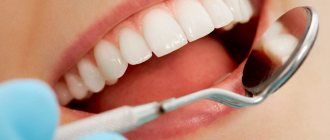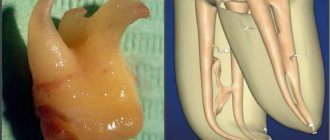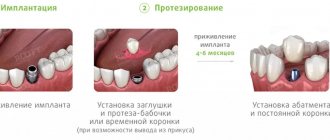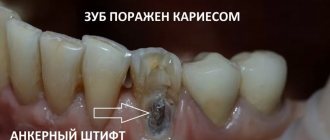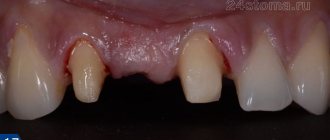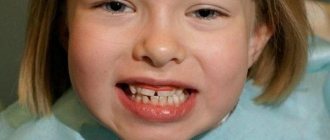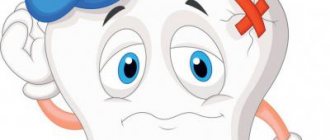Diastema is an enlarged interdental space separating the central incisors of the upper or lower jaw. The gap can be 1-6 mm or more, and even if small, it affects the aesthetics of the smile and attracts attention. An unpleasant consequence of the appearance of a diastema is not only unaesthetics, such a defect affects the quality of speech and causes difficulties in communication.
It is worth noting that diastema is often accompanied by other anomalies in the position and shape of the teeth. Therefore, it is important to take a comprehensive approach to diagnosing and eliminating the defect.
Causes of diastema
The most common cause of diastema is genetic predisposition. Anomalies of the frenulum play a significant role - a short or massive frenulum of the upper lip or its low attachment. Hereditary predisposition is determined by the genetic characteristics of the structure of the dental system and oral tissues. There are also less common reasons:
- the presence of supernumerary impacted dental units - such teeth literally push the front incisors apart, preventing them from closing tightly;
- microdentia - incisor teeth are too small;
- partial edentia - the loss of any tooth in a row can cause the rest to shift;
- late eruption of permanent teeth - defects in the structure of the jaws, discrepancy between their sizes and teeth;
- jaw tumors;
- alveolar cleft;
- bad habits - prolonged sucking of pacifiers, the habit of biting nails, biting pens/pencils, gnawing seeds, etc.
Ask a Question
Classification and reasons for formation
The center of the teeth on one or two jaws at the same time may shift for the following reasons:
- disruption of the process of replacing temporary teeth with permanent ones;
- late eruption;
- TMJ diseases;
- dystopic fangs;
- lack of space in the jaw arch;
- disturbances in the development of one or both jaws;
- abnormalities in tooth size;
- traumatic injuries;
- heredity.
Let's consider an example of a clinical picture with a slight displacement.
A client of a dental clinic has a violation of the replacement of the primary canine with a permanent element on the left in the upper dentition. For this reason, the center line shifted to an empty space - to the left.
On the mobile jaw, on the contrary, there was a delay in changing the canine on the right side. Accordingly, the interincisal straight line is shifted to the place of the missing tooth to the right.
If there is a slight deficiency in the dentition, its expansion in the area of the unerupted unit will lead to lengthening of the jaw arch and a slight shift of the center in the opposite direction. But in orthodontic practice, more complex displacements of the “center of the teeth” are encountered. The optimal methods of their treatment will be discussed below.
Experts classify the anomaly into two types:
- True offset .
Orthodontists also call this type deviation or corpus displacement. The problem is characterized by a discrepancy between the upper point of the interdental papilla and the contact point of the central incisors with the approximate vertical line. This clinical picture mostly occurs due to the absence of a complete row element in the masticatory or frontal zone. In the absence of one of the frontal units, the displacement takes on a pronounced character. - False displacement is a violation of incisal angulation.
It occurs against the background of dysfunction of the mesial-distal inclination of the longitudinal axes of the anterior teeth located in the middle of the upper row. The peculiarity of the anomaly is that the vertical straight line passing through the center of the border region of the middle part of the lip coincides with the gingival papilla, while the interdental contact points are deviated from them.
Types of diastemas
There are true and false diastema. False teeth occur during the period when baby teeth are replaced by permanent teeth. Such a diastema is normal in children - the jaw grows, which explains the appearance of gaps between the upper and lower teeth. By the time the bite change is completed, this feature disappears. True diastema occurs in the permanent dentition and does not disappear on its own, only with dental care.
There are symmetrical and asymmetrical diastemas. In the first case, the incisors are displaced at the same distance, and in the second, one of the teeth is positioned normally, while the other is displaced.
The problem can be aggravated not only by the presence of a gap, but also by rotation of the teeth along the axis, moving forward or, conversely, inside the oral cavity.
Classification of tooth mobility
In modern dental practice, to determine the degree of unnatural mobility of teeth, the classification developed by Honored Scientist of Russia David Abramovich Entin is most often used.
According to this typology, the following levels of mobility are distinguished:
- I degree (instability of position in relation to the coronal parts of adjacent teeth in the oral-vestibular or bucco-lingual directions, amplitude of movement less than 1 mm);
- II degree (mobility in similar directions with an amplitude of more than 1 mm, the appearance of movements in the distal-palatal direction);
- III degree (ability to move in all directions, including vertical);
- IV degree (adding rotational movements of the diseased tooth around its own axis).
Symptoms of diastema
The gap between the teeth can have different severity. The gap is rarely narrow and parallel; more often the central incisors have a deviation, so the gap is characterized by a triangular shape. The apex of such a triangle can be facing both the gums and the cutting edge of the teeth. The diastema is often accompanied by a powerful frenulum of the upper lip, part of which is attached to the crest of the alveolar process and the incisive papilla. The defect is accompanied by other anomalies. The most common of them are the following:
- Trema - lack of close contact between the teeth, gaps not only between the front incisors, but also the chewing teeth;
- microdentia - small teeth;
- malocclusion;
- rotation of the cutters along the axis.
This exacerbates the aesthetic problem. A person may experience embarrassment and discomfort when talking, smiling, and avoid new acquaintances and communication.
Diastema increases the risk of developing periodontal disease in the area of the front teeth. This is due to improper distribution of the chewing load, unstable position of the teeth - lack of lateral supports. Periodontal disease can cause healthy teeth to become loose and there is a high risk of losing them.
Very often the anomaly is accompanied by speech disorders. This is usually expressed in the inability to pronounce certain sounds, a lisp, and a characteristic whistling.
Treatment tactics
There are five methods for correcting the disorder in question:
- Expansion of the tooth area with braces.
- Removal of a tooth.
- The use of elastic traction.
- Surgical method.
- Prosthetics and restoration.
Let's consider each of the treatment methods in detail.
Expansion of teeth with braces
Most often, the most complex displacement is expressed in the discrepancy between the center of the teeth of the upper and movable jaw.
In this case, the doctor’s task is to ensure that not only the center of the two rows coincides, but also that the jaw midline completely matches the line passing through the center of the face.
If there is a shortage of space in the jaw arches and there is an asymmetrical displacement, braces are used to expand the problem area on the top row on the right side.
At the same time, on a mobile jaw, the correction by the system occurs in the opposite way - the problem area on the left expands. According to this principle, treatment with a brace system will be successful and the depth of overlap of teeth in the frontal zone will be noticeably normalized.
Remarkable! In the treatment of the anomaly in question, classical brace designs are capable of showing good results.
The video presents tactics for treating anomalies using combined braces.
Removal of a tooth
When the midline of one of the arches has a significant shift, it means that the center has shifted due to the long absence of a tooth after its removal, say, the 4th unit on the left.
In this case, the correction tactics are based on creating space in the side to which it is planned to shift the center. To do this, the doctor performs an extraction of the quad on the right, and a displacement is planned in this direction.
Application of elastic rods
Elastic cords are used in the treatment of dental center disorders as auxiliary elements. They cannot eliminate the problem on their own and be the basis for correction.
A correction plan based solely on orthodontic rubber bands will not bring the desired result.
Modern methods for correcting shortening of the dentition and the expected result.
This publication contains all the most important information about tooth intussusception.
Here https://orto-info.ru/zubocheliustnye-anomalii/ryadov/chto-skeletnaya-opora.html find out what absolute skeletal support is.
Surgical intervention
Surgical intervention to eliminate displacement (doctors call the rotation method) is one of the best options for effective treatment of pronounced deviations from the norm. The essence of the technique is to shift the upper jaw relative to the skull.
Features of this type:
- Making an incision in bone tissue.
- Changing the position of the upper jaw under mechanical pressure.
This type of surgical intervention helps to radically change the situation with the position of the teeth and restore the ideal center.
Prosthetics and restoration
Often, among conservative methods of treating midline displacement, experts consider aesthetic correction to be the optimal choice: prosthetics with crowns, restoration with veneers, or grinding of cutting areas followed by restoration of the integrity of the tooth with a composite.
The restoration of central incisors with wide diastemas using the method of building up the walls of the teeth is widely used. For these purposes, a polymer that is optimal for the shade of teeth is selected.
The main task of the dentist in the process of this manipulation is to bring the shape of each problem unit as close as possible to the natural one.
Diagnosis and elimination
The distance between the front teeth is noticeable to the naked eye. But diagnostics are necessary to find out the causes of the defect. The dentist examines the oral cavity and may prescribe the following examinations:
- targeted radiography;
- panoramic shot, or OPG;
- taking impressions and making a plaster model of the jaws.
The specialist will take into account the shape, size, position of the incisors, the structure and condition of the root system, examine the frenulum, determine the symmetry of the defect, the nature of the bite and other parameters. Only after this the doctor will suggest the optimal method for correcting the deficiency. Sometimes additional consultation with a dental surgeon, orthodontist, orthopedic dentist, or periodontist may be required.
Treatment of diastema may require the use of orthopedic, orthodontic, surgical methods, or a combination of these. There are several common schemes:
- Cosmetic restoration - installation of composite veneers.
- Orthopedic method. Installation of ceramic veneers or crowns: metal-ceramic, all-ceramic, etc. Restoration of dentition using implants with artificial crowns and other types of structures.
- Surgical method. Plastic surgery of the frenulum of the lips or tongue, removal of impacted, dystopic, supernumerary teeth.
- Orthodontic method. Installation of removable or fixed systems that allow you to change the position of teeth (plates, braces).
Cosmetic restoration is used for microdentia if the roots of the incisors are located correctly, and the problem arose due to the deformation of the crowns or their small size. Veneers can also be used for minor defects in the enamel of the incisors.
The orthopedic method is relevant when the interdental gap arises as a result of the absence of adjacent teeth. Also, installing artificial crowns will help with partial destruction of the incisors.
Plastic surgery of the frenulum is necessary when it is shortened or has a changed structure. Sometimes this method is combined with other methods. If orthodontic treatment is planned, the patient will first have the frenulum adjusted. After this, if the doctor deems it necessary, the installation of orthopedic structures will be prescribed.
Indications for installation
It is worth noting that aligners are recommended only if the clinical picture allows us to determine the pathology as mild or moderately severe. At later stages of development, the pressure exerted by the polymer structure becomes insufficient for displacement, which necessitates the installation of braces or a full-fledged operation.
The list of pathologies that can be eliminated with the help of aligners includes:
- Anomalies of the dentition - rotation, crowding, the presence of deviated units;
- Incorrect development of the bite, characterized by a shift in the midline and a violation of the occlusal closure;
- Insufficiency of the dental arch, requiring narrowing or expansion;
- Interdental gaps that disrupt aesthetics and contribute to the accumulation of infection.
In addition, the use of aligners is recommended if there are factors that limit other methods - for example, an allergy to medical steel, or insufficiency of bone tissue that precludes dental prosthetics.
Why eliminate diastema
Some patients consider the diastema to be a peculiar highlight and do not think about how to remove the gap between the front teeth. However, aesthetic indications are not the only reason to see a doctor. Normally, the lateral surfaces of all teeth touch. This helps maintain a stable position of both individual teeth and the entire dentition - this way the teeth simply have nowhere to move. Diastema can cause changes in the position of other teeth and provoke the development of gum disease due to a violation of the distribution of chewing load.
A large gap between the incisors changes diction, and in case of serious problems with pronunciation, even after correction, the help of a speech therapist is often required. Therefore, it is important to deal with the defect as early as possible in order to prevent the development of complications.
At STOMA clinics you can get professional help in eliminating diastema. Our specialists perform plastic surgery of the lip and tongue frenulum, install veneers and select appropriate methods of bite correction. You can make an appointment for a consultation by calling the specified phone number or using a special form on the website.
Why do teeth shift?
The most common reason is a violation of the integrity of the dentition
. As a result, antagonist teeth cease to participate in the chewing process, and the load on other (working) teeth increases. The contact of the teeth (occlusion) is disrupted and becomes traumatic, destroying the ligaments and stretching the collagen fibers that hold the tooth. A tooth that does not have contact when the jaws are closed begins to move vertically. So, if the lateral upper teeth are missing, then the lower ones move vertically upward. And if there are no lower teeth, the upper ones are displaced. For large defects (6 or more missing teeth), the movement is strictly vertical. But almost every tooth has a main and secondary antagonist. They prevent the tooth from moving strictly vertically. With small defects (1-3 teeth), there is also a tilt towards the lost units. The displacement of teeth after extraction becomes more pronounced the longer prosthetics are delayed. Therefore, dentists recommend restoring the dentition without delay.
Other reasons:
- Caries of occlusal surfaces
(points of contact when closing the jaws)
The more the crown is destroyed, the less the tooth participates in the chewing process, up to its complete exclusion from it. Then the displacement mechanism develops according to the same pattern as with dentition defects.
- Increased enamel abrasion
A change in tooth height, even by one or two millimeters, changes the entire articulatory picture, disrupting the occlusion and leading to the same results as in the first two cases.
- Periodontal disease
The periodontium is a ligamentous-muscular apparatus that holds the tooth in its socket. With periodontitis, the ligaments weaken and cannot hold the teeth in their original position. They begin to stagger and “move apart” to the sides. A classic example of combined movement during periodontal inflammation is the fan-shaped discrepancy of the upper frontal teeth.
- Wisdom teeth
They begin to grow after the dentition has formed. An obstacle in the form of a neighboring tooth can stop growth, or turn the “eight” to the side. Abnormally located teeth are not in the bite and violate the occlusion. An impacted (unerupted) tooth can cause the front teeth to shift and become crowded.
- Wisdom teeth removal
One of the complications is tooth displacement after wisdom tooth removal. Extraction can disrupt the occlusion by moving the adjacent tooth, the “seven,” to the vacant space.
